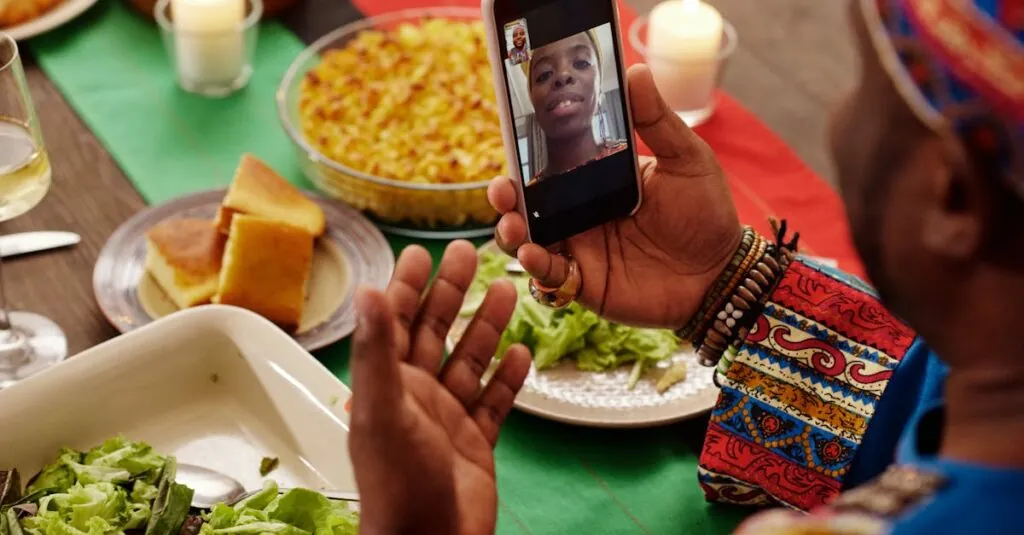Family traditions are the glue that holds us together, but let’s be honest—sometimes they can feel more like sticky tape than glue. Whether it’s Grandma’s infamous meatloaf or Uncle Bob’s questionable karaoke skills, these quirky customs shape who we are. A “my family traditions worksheet” isn’t just a fun activity; it’s a treasure map to uncovering the unique quirks that make your family, well, your family.
Table of Contents
ToggleOverview of My Family Traditions Worksheet
A “my family traditions worksheet” serves as a practical tool for families to document their unique customs. This worksheet encourages exploration of various traditions that shape family identity. By using it, families can capture essential elements, such as recipes, holiday celebrations, and memorable anecdotes. Each section on the worksheet invites reflection on how these practices impact family bonds.
Participants fill out different segments, detailing specific traditions and their meanings. Individuals might focus on the origins of recipes passed down through generations. Sections may include prompts for noting favorite family songs or stories shared at gatherings. This format allows families to discover shared experiences that define their heritage.
As families engage with the worksheet, they gain deeper insights into their collective history. They can recognize recurring themes and values reflected in their traditions. A strong emphasis on preserving these customs helps solidify family connections. Each completed worksheet offers a snapshot of a family’s legacy, creating a tangible resource for future generations.
Utilizing the worksheet promotes lively discussions about cherished memories. This interactive approach fosters understanding and appreciation of diverse cultural backgrounds. With every tradition documented, families celebrate their uniqueness while building unity. Ultimately, this simple yet effective tool can enhance family cohesion and promote pride in their heritage.
Importance of Family Traditions
Family traditions play a crucial role in nurturing connections among family members. They foster a sense of belonging and identity, highlighting the unique heritage each family shares.
Strengthening Bonds
Family traditions serve as a foundation for building strong relationships. Engaging in shared activities, like preparing holiday meals or celebrating birthdays, encourages togetherness. Families bond over these routines, which may include storytelling or game nights. Participating in rituals creates consistency and predictability, essential for emotional security. Trust grows as family members share responsibilities and experiences, reinforcing their connections. As traditions evolve, families adapt while maintaining their core values, ensuring memories remain relevant. Ultimately, these practices promote love and unity, providing families with a solid support system.
Creating Memories
Creating lasting memories is one of the most significant aspects of family traditions. Unique activities, such as family vacations or seasonal celebrations, become cherished stories over time. Families often look back fondly on these moments, which reinforce their identity. Documenting experiences in a family traditions worksheet aids in preserving these memories for future generations. It invites family members to reflect on their favorite traditions and relive valuable experiences together. Memorable events, like annual reunions or holiday gatherings, foster appreciation for shared history. In turn, these memories contribute to a family’s narrative, enriching their legacy and enhancing pride in their background.
How to Use the Worksheet
The “my family traditions worksheet” is a simple tool for exploring family heritage. It captures unique customs and traditions that shape family identity.
Step-by-Step Guide
- Gather family members before starting the worksheet.
- Discuss various traditions each person values.
- Begin filling out the worksheet by answering specific prompts.
- Include details like recipes and special meanings.
- Review completed sections together, encouraging dialogue.
- Store the finished worksheet in a visible place for easy reference.
Tips for Engagement
Engaging all family members during the process helps create a richer experience. Encourage everyone to share their favorite memories. Utilize open-ended questions to prompt discussion. Additional elements, such as photos or drawings, can enhance the worksheet’s appeal. Celebrate completion by planning an event to showcase shared traditions. Consider revisiting the worksheet regularly to update and reflect on evolving family practices.
Examples of Family Traditions
Family traditions manifest in various forms, encapsulating practices that define unique familial identities. Two primary categories include cultural traditions and personal traditions.
Cultural Traditions
Cultural traditions often reflect heritage and shared histories within families. Many families celebrate specific holidays like Diwali or Christmas, inviting relatives to participate in festivities that highlight their cultural roots. Traditional meals play a significant role, with recipes passed down through generations, preserving flavors and techniques. Observing rituals such as wedding ceremonies or cultural festivals also strengthens connections to ancestral customs. These events create memorable experiences, reinforcing the family’s cultural identity.
Personal Traditions
Personal traditions center around unique family experiences that foster closeness. Family game nights or movie marathons become beloved staples, creating lasting memories and shared laughter. Celebrating birthdays in special ways, such as themed parties or meaningful gifts, forms cherished rituals. Engaging in annual trips to favorite vacation spots brings excitement and adventure. Each tradition reflects collective values, confirming relationships and enhancing emotional bonds among family members.
Benefits of Documenting Traditions
Documenting family traditions through a worksheet offers numerous advantages. Firstly, it fosters closer relationships among family members. When families engage in meaningful discussions about their customs, they strengthen bonds and create a supportive atmosphere.
Secondly, this practice enhances cultural understanding. Families exploring their heritage can uncover unique backgrounds and customs. Sharing these discoveries contributes to a sense of pride in one’s culture.
Additionally, preserving traditions cultivates lasting memories. Families recall specific occasions and shared experiences while filling out the worksheet. Those cherished moments become stories treasured for future generations.
Moreover, it encourages reflection and appreciation. Families consider the significance behind their traditions. Recognizing shared values allows members to appreciate their connections and develop a deeper sense of identity.
Creating a visual representation of traditions makes them tangible. Individuals can refer back to the documented customs and continue the legacy. A well-maintained worksheet becomes a family heirloom, passing down stories to younger generations.
Furthermore, engaging with the worksheet sparks creativity. Families can include drawings, photos, and personal anecdotes, making it an enjoyable activity. Adding these elements transforms the worksheet into a vibrant celebration of traditions.
Utilizing a family traditions worksheet also serves as a tool for growth. Families can examine how traditions evolve over time, helping them adapt while maintaining core values. This adaptability fosters resilience and strengthens family unity in an ever-changing world.
Overall, documenting traditions enhances family identity, deepens connections, and preserves cultural heritage, making it an essential practice for fostering cohesion and pride.
Family traditions are more than just customs; they’re the threads that weave families together. The “my family traditions worksheet” is a powerful tool that helps families explore and document these unique practices, deepening their connections and understanding of one another. By engaging in this activity, families can celebrate their shared history and create a lasting legacy for future generations.
As families fill out the worksheet and reflect on their traditions, they cultivate a sense of pride and belonging. This process not only strengthens bonds but also encourages the sharing of stories and experiences that shape their identity. Embracing these traditions ensures that cherished memories and values continue to thrive, enriching family life for years to come.



